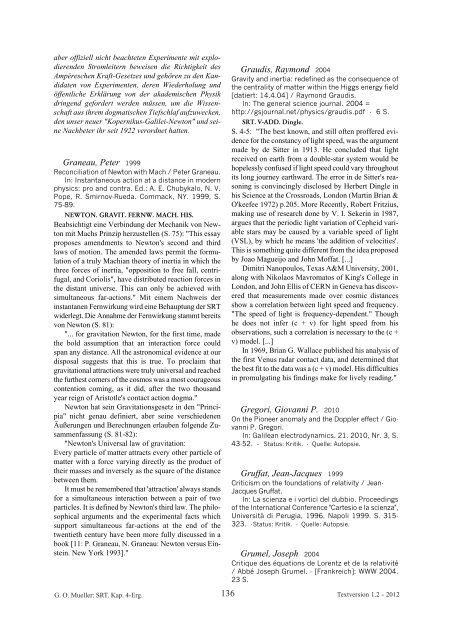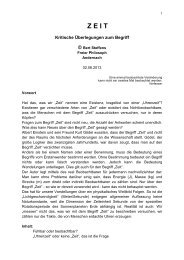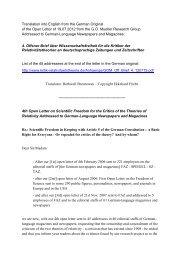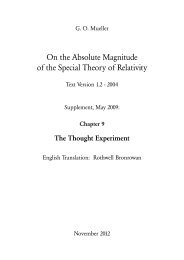2394 weitere kritische Veröffentlichungen - Kritische Stimmen zur ...
2394 weitere kritische Veröffentlichungen - Kritische Stimmen zur ...
2394 weitere kritische Veröffentlichungen - Kritische Stimmen zur ...
Erfolgreiche ePaper selbst erstellen
Machen Sie aus Ihren PDF Publikationen ein blätterbares Flipbook mit unserer einzigartigen Google optimierten e-Paper Software.
aber offiziell nicht beachteten Experimente mit explodierenden<br />
Stromleitern beweisen die Richtigkeit des<br />
Ampèreschen Kraft-Gesetzes und gehören zu den Kandidaten<br />
von Experimenten, deren Wiederholung und<br />
öffentliche Erklärung von der akademischen Physik<br />
dringend gefordert werden müssen, um die Wissenschaft<br />
aus ihrem dogmatischen Tiefschlaf aufzuwecken,<br />
den unser neuer "Kopernikus-Galilei-Newton" und seine<br />
Nachbeter ihr seit 1922 verordnet hatten.<br />
Graneau, Peter 1999<br />
Reconciliation of Newton with Mach / Peter Graneau.<br />
In: Instantaneous action at a distance in modern<br />
physics: pro and contra. Ed.: A. E. Chubykalo, N. V.<br />
Pope, R. Smirnov-Rueda. Commack, NY. 1999, S.<br />
75-89.<br />
NEWTON. GRAVIT. FERNW. MACH. HIS.<br />
Beabsichtigt eine Verbindung der Mechanik von Newton<br />
mit Machs Prinzip herzustellen (S. 75): "This essay<br />
proposes amendments to Newton's second and third<br />
laws of motion. The amended laws permit the formulation<br />
of a truly Machian theory of inertia in which the<br />
three forces of inertia, "opposition to free fall, centrifugal,<br />
and Coriolis", have distributed reaction forces in<br />
the distant universe. This can only be achieved with<br />
simultaneous far-actions." Mit einem Nachweis der<br />
instantanen Fernwirkung wird eine Behauptung der SRT<br />
widerlegt. Die Annahme der Fernwirkung stammt bereits<br />
von Newton (S. 81):<br />
"... for gravitation Newton, for the first time, made<br />
the bold assumption that an interaction force could<br />
span any distance. All the astronomical evidence at our<br />
disposal suggests that this is true. To proclaim that<br />
gravitational attractions were truly universal and reached<br />
the furthest corners of the cosmos was a most courageous<br />
contention coming, as it did, after the two thousand<br />
year reign of Aristotle's contact action dogma."<br />
Newton hat sein Gravitationsgesetz in den "Principia"<br />
nicht genau definiert, aber seine verschiedenen<br />
Äußerungen und Berechnungen erlauben folgende Zusammenfassung<br />
(S. 81-82):<br />
"Newton's Universal law of gravitation:<br />
Every particle of matter attracts every other particle of<br />
matter with a force varying directly as the product of<br />
their masses and inversely as the square of the distance<br />
between them.<br />
It must be remembered that 'attraction' always stands<br />
for a simultaneous interaction between a pair of two<br />
particles. It is defined by Newton's third law. The philosophical<br />
arguments and the experimental facts which<br />
support simultaneous far-actions at the end of the<br />
twentieth century have been more fully discussed in a<br />
book [11: P. Graneau, N. Graneau: Newton versus Einstein.<br />
New York 1993]."<br />
G. O. Mueller: SRT. Kap. 4-Erg.<br />
136<br />
Graudis, Raymond 2004<br />
Gravity and inertia: redefined as the consequence of<br />
the centrality of matter within the Higgs energy field<br />
[datiert: 14.4.04] / Raymond Graudis.<br />
In: The general science journal. 2004 =<br />
http://gsjournal.net/physics/graudis.pdf - 6 S.<br />
SRT. V-ADD. Dingle.<br />
S. 4-5: "The best known, and still often proffered evidence<br />
for the constancy of light speed, was the argument<br />
made by de Sitter in 1913. He concluded that light<br />
received on earth from a double-star system would be<br />
hopelessly confused if light speed could vary throughout<br />
its long journey earthward. The error in de Sitter's reasoning<br />
is convincingly disclosed by Herbert Dingle in<br />
his Science at the Crossroads, London (Martin Brian &<br />
O'keefee 1972) p.205. More Recently, Robert Fritzius,<br />
making use of research done by V. I. Sekerin in 1987,<br />
argues that the periodic light variation of Cepheid variable<br />
stars may be caused by a variable speed of light<br />
(VSL), by which he means 'the addition of velocities'.<br />
This is something quite different from the idea proposed<br />
by Joao Magueijo and John Moffat. [...]<br />
Dimitri Nanopoulos, Texas A&M University, 2001,<br />
along with Nikolaos Mavromatos of King's College in<br />
London, and John Ellis of CERN in Geneva has discovered<br />
that measurements made over cosmic distances<br />
show a correlation between light speed and frequency.<br />
"The speed of light is frequency-dependent." Though<br />
he does not infer (c + v) for light speed from his<br />
observations, such a correlation is necessary to the (c +<br />
v) model. [...]<br />
In 1969, Brian G. Wallace published his analysis of<br />
the first Venus radar contact data, and determined that<br />
the best fit to the data was a (c + v) model. His difficulties<br />
in promulgating his findings make for lively reading."<br />
Gregori, Giovanni P. 2010<br />
On the Pioneer anomaly and the Doppler effect / Giovanni<br />
P. Gregori.<br />
In: Galilean electrodynamics. 21. 2010, Nr. 3, S.<br />
43-52. - Status: Kritik. - Quelle: Autopsie.<br />
Gruffat, Jean-Jacques 1999<br />
Criticism on the foundations of relativity / Jean-<br />
Jacques Gruffat.<br />
In: La scienza e i vortici del dubbio. Proceedings<br />
of the International Conference "Cartesio e la scienza",<br />
Università di Perugia, 1996. Napoli 1999. S. 315-<br />
323. -Status: Kritik. - Quelle: Autopsie.<br />
Grumel, Joseph 2004<br />
Critique des équations de Lorentz et de la relativité<br />
/ Abbé Joseph Grumel. - [Frankreich]: WWW 2004.<br />
23 S.<br />
Textversion 1.2 - 2012





